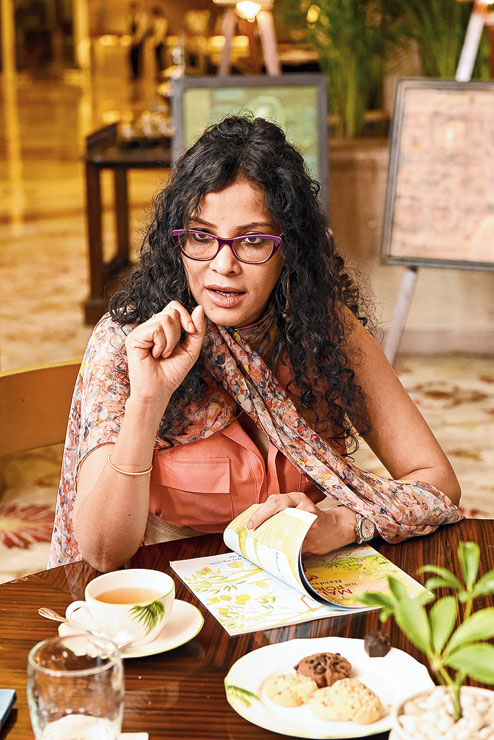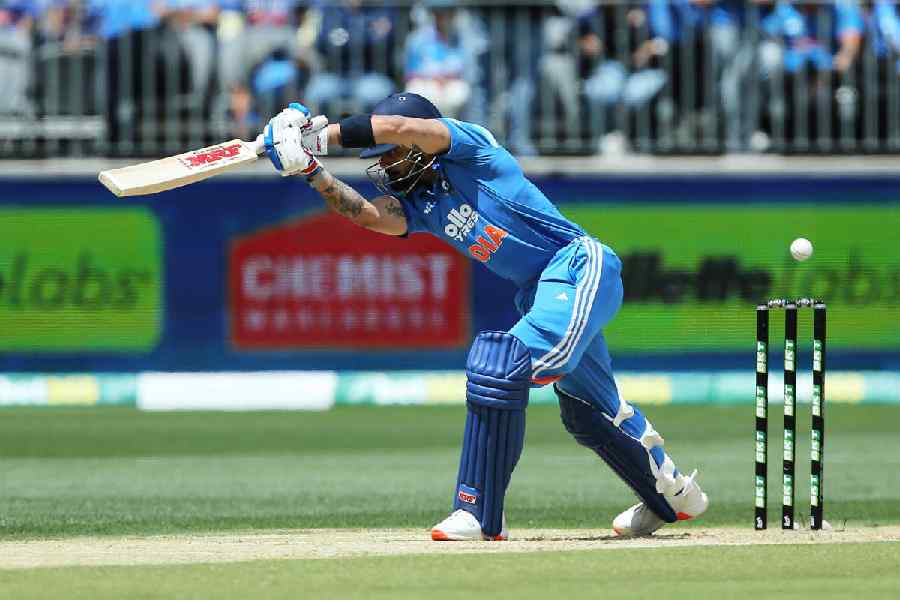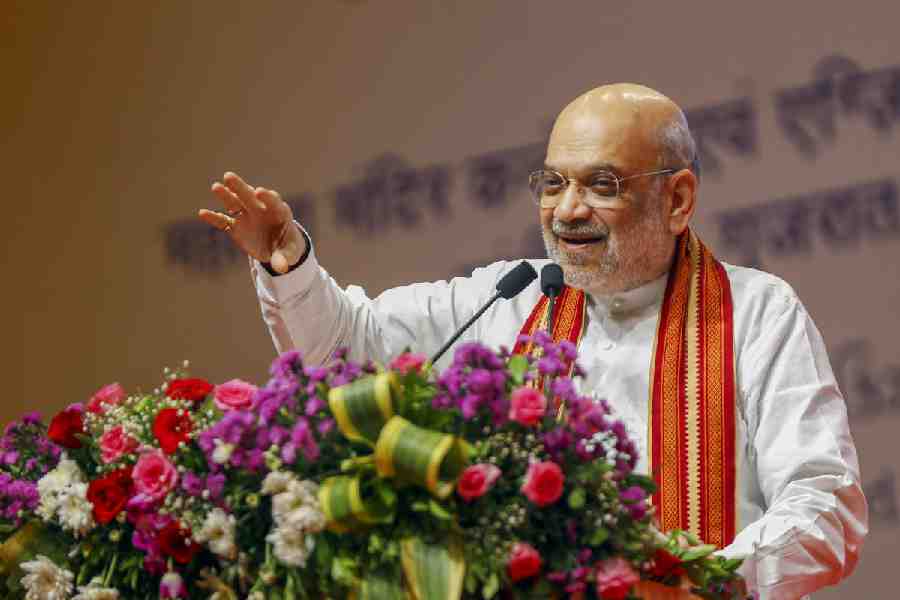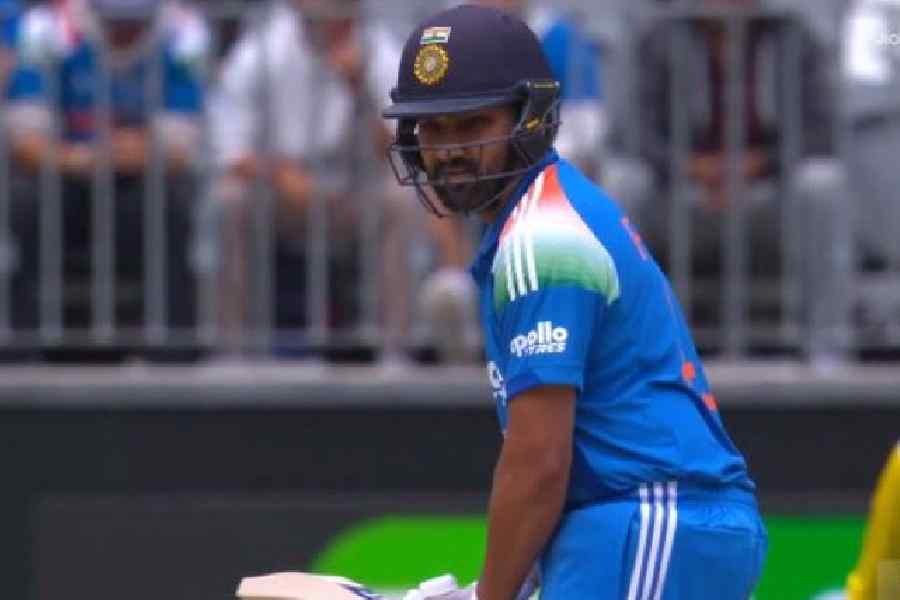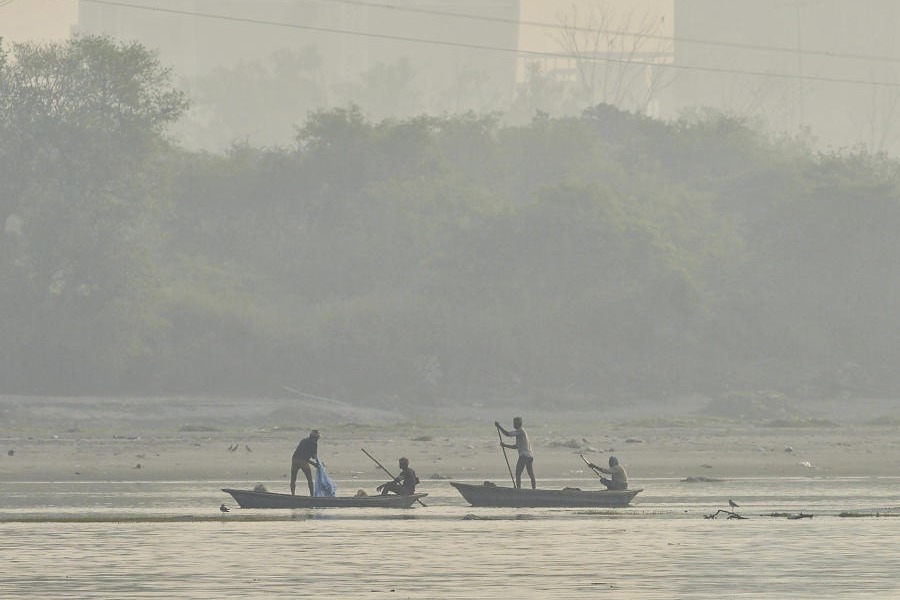We last saw her sensuously smeared with paint in Rang Rasiya and now Nandana Dev Sen is up to something just as colourful — an illustrated children’s book titled Mambi and the Forest Fire. Published by Puffin Books, it tells the story of a little monkey and how she learns to embrace who she is. On January 13, the younger daughter of Amartya Sen and Nabaneeta Dev Sen chatted with theatre veteran Dolly Basu, who does workshops with children, and child psychiatrist Rima Mukherji for Aaj Adda, steered by Modhurima Sinha of Taj Bengal, and t2.

Pictures: Rashbehari Das
The writing gene
t2: Nandana, how did a book happen?
Nandana Dev Sen: Well, I’ve written for The Telegraph many times, actually (laughs)... about Pujo, my family, the right to education, the importance of gender sensitivity in communication on child protection….
When I was in Bombay, I was dividing my time between three worlds, in a way. But they were interconnected… cinema, writing and child rights. In fact most of my films, the reason why they seem like such eccentric choices, is because all of them, with the single exception of an action film I did (Tango Charlie) — because I always thought that if I did one action film then I’d stop being clumsy — have been connected to some social or political cause that I am passionate about.
Black, which was my first film, was about the rights of disabled children. I have done films on child sexual abuse (The Silence), etc. And I also did write whenever I was asked. I was so busy as an actor that I didn’t have enough time to focus on writing as much as I would have liked to. Now that I have moved away from Bombay (Nandana and husband John Makinson divide their time between New York and London), I made a conscious choice about writing more.
Modhurima: Children’s writing in particular?
Nandana: Writing in general. But children’s writing is where I have my work cut out for me already. There are four other books that I have been asked to do, other than these two that I have already done (Mambi and Kangaroo Kisses). I’ve also been asked to write two adult books....
Children’s writing has always been very close to me. Initially because of the tradition that I come from. My mother and grandmother (Radharani Devi), apart from being very successful writers for adults, have always written for children. Even my grandfather (Narendra Dev), he edited a children’s magazine. And I grew up in a house that had the most incredible collection of children’s books from all over the world. I was a voracious reader and by the time I was 10 or 12, I was reading books that were not just for children. Because I read I don’t remember ever being bored as a child. The other reason why I am very strongly drawn to children’s literature is because of the work that I have done with children.
What draws me to film is the same thing that draws me to children’s literature, which is the fact that I believe in each medium’s transformative capacity. I think films can change the way we look at the world and therefore can go a long way in changing the world. The same way, children’s literature, especially, is a genre that’s extremely influential.
Let the children breathe
Dolly Basu: Our children are living in very different times than our childhood. Now children are living in a very, very complicated world. Once in class I asked the children to name their favourite flower, and they were all looking at each other.
Nandana: Why do you think they didn’t have an answer?
Dolly: Because they are not used to going to parks! They are not used to going close to Nature. When I spoke to the parents, I discovered that the only outing most of these children have is either to a restaurant or a mall. We grew up going to picnics. How many children go for picnics now? And Nature teaches a lot.
And parents are now a big issue — My child MUST stand first, must do very, very well. If her child has 10 tuitions, then my child should have 12 tuitions.... But it’s so very important to let our children breathe.
All study and no play
Rima: I’ll start with one of my cases. A couple came to me from the suburbs. They are not that highly educated but they have got their child admitted to an English-medium school. The child is in Class I, six years old, and has been brought to me because he is restless and has concentration problem.
I asked, ‘Does the child play? Is there any outdoor physical activity?’ The mother and father looked completely shocked and said, ‘Do you know, he is in an ICSE school?’
This is a Class I child, mind you. The number of children who go out and play, out of 1,000, I would say, is less than 10. One of the reasons is that there are no parks to play. So even if a parent would allow a child to play, there is no place for them to play nearby. But parents will take somebody from Dum Dum to Behala for tuitions at the age of six but they can’t take their kid two blocks away to a place where they can play!
Secondly, there are no other children to play with. Because they are all going for tuitions. And when I talk about play, I am talking about free play, where they are allowed to use their imagination.
If you love storybooks, as Nandana said, you are not going to be a bored child, and you are not going to be a bored adult.

The iPad competition
Dolly: That’s why books like Mambi are very important now. When I now read out Panchatantra and Vikram-Betaal, I have to change little bits, because Panchatantra, I feel, has a lot of violence. And the whole concept of ‘and they lived happily ever after..’ or Prince Charming... with changing times we need to have books for children that are meant for the children of now. And they must be easy reads. Presentation matters a lot now. Because there is so much competition… the book needs to be very attractive.
Nandana: Especially when you are talking about four to six-year-olds, their attention span is very little. And you are competing with iPads, with television, you are competing not just with a riot of colour but moving images, tactile images.
Read them a story
Rima: Children’s entertainment has become very passive. Either they go for discipline sports, like cricket or tennis coaching, or they are watching television. And this is encouraged by parents because then they don’t have to take this child out to play and supervise them.
All children’s programmes have a lot of violence, which is why they become so immune to violence. Violence in a book is not the same as violence on screen. If kids were allowed to go out and play and read books, the concentration pathways would develop, and they would not be restless. We are branding a lot of children as ADHD (attention deficit hyperactivity disorder) when actually they are just people for whom parents have not sat down and read them books. Parents should read them a book till a certain point and say, ‘Now you read for yourself and find out what happens next.’ That’s how you get them interested in reading.
Modhurima: Do you recommend reading as part of your treatment? And does it work?
Rima: Absolutely. The ones who read are a different breed altogether. They are far better adjusted.

Monkey business
t2: Nandana, your protagonist is a she monkey. But she’s not coy, she is adventurous and athletic. Was that a conscious decision?
Nandana: Yeah, yeah, absolutely. In fact, I was very sure that Mambi needed to be a girl. Saskia (Pekelharing), my illustrating partner, and I work very closely and we worked on the physicalisation of Mambi very hard. Because we wanted to make it clear that she was a she, but we didn’t want her to be a nyaka monkey, you know.
Modhurima: I love the little flower behind her ear.
Nandana: So we added the flower but we decided not to have the flower on the cover. Because we didn’t want it to be about gender. We wanted little boys to see themselves in it as much as little girls. But it was very important to me that the heroine was a female monkey.
Modhurima: Why a monkey?
Nandana: I think partly because we have such a strong tradition of fables which have monkeys, not just Hanuman, a lot of the Hitopadeshas… and not just in India. A lot of Aesop’s fables have monkeys in them, a lot of Asian Buddhist literature has monkeys — the wise monkey, the trickster monkey.... but also I am very close to my niece, my didi’s (Antara Dev Sen) little girl Hiya, who has just turned six and I would always call her my ‘monkey princess’. She was one of the muses… and I have two other nieces by my brother and they are also little monkeys.
Samhita Chakraborty
The first book I remember reading as a child was.... Tell t2@abp.in

